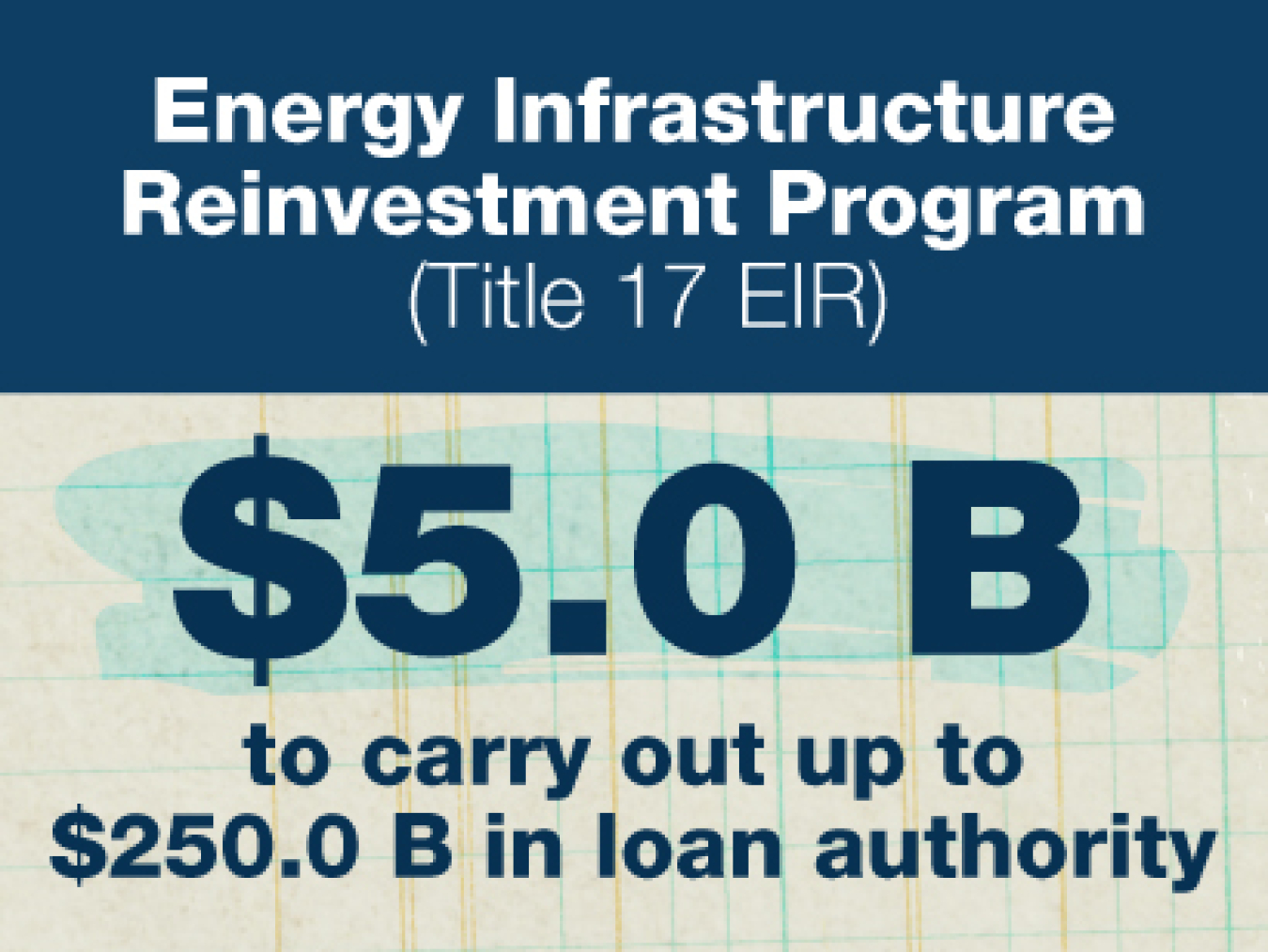
The Inflation Reduction Act makes the single largest investment in climate and energy in American history. IRA substantially increased the Loan Program Office’s (LPO) existing lending authorities by more than $100 billion, and also created a new loan program, the Energy Infrastructure Reinvestment (EIR) Program (Title 17 section 1706).
IRA provided EIR with $5 billion through Fiscal Year 2026 for the Department of Energy to support loan guarantees up to $250 billion for energy infrastructure-related projects. These projects will reinvest in energy infrastructure* that has “ceased operations” – think power plants that have been retired but can be refinanced and replaced with established or emerging clean energy sources like renewables and nuclear or older, idled assets that can be repowered or replaced with more efficient units. The program could also support retooling existing energy infrastructure for new manufacturing plants, or it could make the existing “operating” energy infrastructure more efficient by adding things like carbon management and emission control technologies. The program could also finance transmission upgrades or reconductoring, or uprating existing nuclear or hydropower facilities. In addition, EIR differs from the existing Title 17 program in that EIR does not have an innovation requirement. EIR is meant to revitalize our current infrastructure at the pace needed to address the climate crisis.
Critically, EIR applicants must demonstrate how they will engage with and and how their project will benefit communities where the investment is taking place. The Interagency Working Group on Coal & Power Plant Communities & Economic Revitalization has been listening directly to energy communities across the United States over the past year to better understand what kinds of projects individual communities are most interested in, and what kinds of investment will be most effective in meeting President Biden’s goal of creating high-quality jobs and economic prosperity in those communities that have helped to power America’s economic growth over the past century.
Community benefits aren’t confined to jobs and economic growth. EIR projects may include clean energy deployment and as well as projects that decrease the pollutant and emission profile of operating infrastructure. Given the climate imperative of the IRA, the “retooling, repowering, repurposing, or replacement” of assets must also, of course, avoid, reduce, utilize, or sequester air pollutants or anthropogenic greenhouse gas (GHG) emissions if those projects involve electricity generation through the use of fossil fuels. The same consideration also applies to improvements to operating infrastructure. EIR also allows for remediation of environmental damages associated with a project’s eligible energy infrastructure, whether that be through a revitalization, retool, or upgrade of the infrastructure. Support for environmental remediation could take many forms: there is an opportunity for brownfield sites, current and former mine lands, and sites that have been part of the nation’s nuclear legacy and cleanup mission.
Some examples of potential projects, subject to specific review:
"Ceased operations"
- Replacing fossil electricity generation with established cleaner sources
- Replacing fossil electricity generation with emerging clean firm power sources
- Repowering or replacing older renewable assets with more efficient / state-of-the-art renewable assets
- Retooling fossil-based energy infrastructure for manufacturing
- Replacing fossil-based industrial processes with decarbonized industrial processes
- Repurposing oil pipelines for clean hydrogen or CO2 transport
- Site remediation
"Operating"
- Retrofitting existing fossil assets
- Refinancing, upgrading, uprating existing nuclear or hydropower facilities
- Transmission upgrades
- Refinery upgrades
- Site remediation
The above represents just a handful of potential examples and are by no means exhaustive.
What’s Next for EIR?
As with interpreting any legislation, there are plenty of open questions to be asked as we jump-start the new program. But because IRA provides appropriations and loan authority for EIR only through Fiscal Year 2026, we’re eager to move.
LPO plans to provide initial implementing guidance and collect public comment on program design for the EIR program in an upcoming Title 17 Notice of Proposed Rulemaking. In September, LPO will kick off a series of listening sessions with industry, power plant communities, the environmental and equity communities, and others to determine how to structure this exciting new program and inform potential EIR use cases.
In the meantime, interested applicants can review initial guidance on applying to the program HERE. Interested applicants can request a pre-application consultation by emailing lpo@hq.doe.gov.
***
Next up: Next week I’ll provide an update on Carbon Dioxide Transportation Infrastructure Finance and Innovation (CIFIA) Program created by the Infrastructure Investment and Jobs Act.
* For the purpose of this program, "energy infrastructure" is defined by the Inflation Reduction Act of 2022 as “a facility, and associated equipment, used for: the generation or transmission of electric energy; or the production, processing, and delivery of fossil fuels, fuels derived from petroleum, or petro-chemical feedstocks.”

